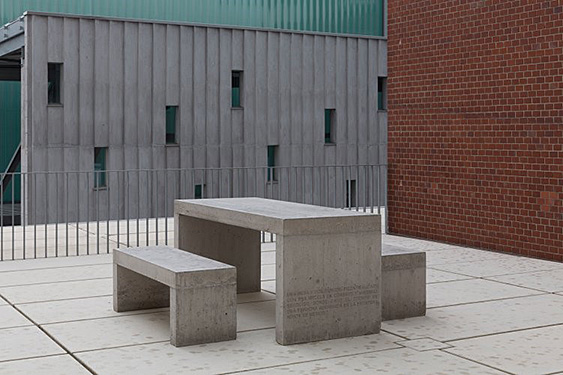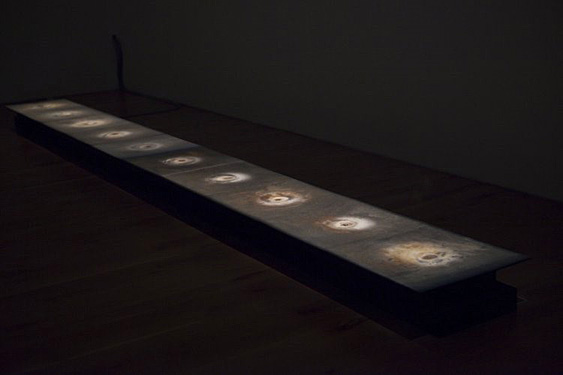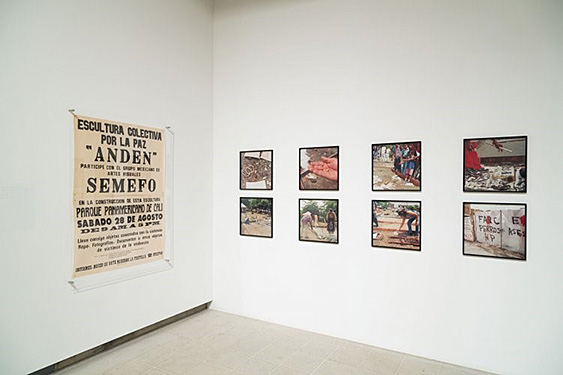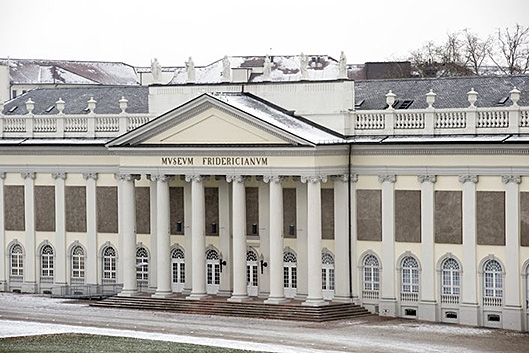October 8, 2015
“Each bubble is a body.”[1] Teresa Margolles - Hidden Terror
Written by Christina Grevenbrock

The simplest form of a desk and two benches, designed for outside use, made of concrete: Mesa y Dos Bancos (2013) by Teresa Margolles does not necessarily look like a work of art on first glance. People most probably pass it, or even sit down and rest peacefully, without ever realizing they are dealing with an artwork, let alone guess its gruesome background. These pieces of street furniture were not solely made of cement, there is material taken from the ground where a person was murdered at the northern Mexican border mixed into it. The seemingly harmless resting place which is executed in the most unadorned, minimal style possible, is in fact tangibly linked to gruesome acts of violence happening in Mexico.

Violence and the dead human body are major topics in the sociopolitical art of Teresa Margolles. Born in the 60s in Culiacán, Mexico, she unfalteringly deals with the social and political injustices in her home country. It is hardly surprising that her art shocks visitors, even more so, because the viewer is faced by the reality of death in a disturbingly unmediated fashion. This effect is due to her very specific use of material: Many of her works consist of substances or objects that have been in close contact either to violent crimes or to dead bodies. Some examples are: Water with which corpses have been cleaned, blood soaked earth, broken glass, fabric drenched in body fluids… [2] Judging from this list, a reader would probably expect horrific and appalling objects, when in reality there is a huge discrepancy between a usually very clean, even beautiful appearance and the dreadful content of her works. Margolles’ art is executed in a very minimal, aesthetic style that stands in stark contrast to its abject material and subject matter.
[3] Plancha (2010), for example, uses water that has been used to cleanse corpses before the autopsy. The water slowly and erratically drips onto heated metal plates. Each time a drop hits one of the hot surfaces, it evaporates with a hiss, leaving a faint odour and stains that intensify over time.
Margolles points out how the social injustices in Mexico translate into violence by taking the violence and translating it into simple, focused and poetic forms. The beauty of them is intentionally not what visitors would expect to match such brutal content.
Her work is highly informed by minimal art and other forms of socially and politically involved art since the 1960s. In terms of social responsibility, Margolles’ art can be very roughly divided into two tactics: One line of works is aimed at local people and consists of measurements to help them cope, the other one is for the public, designed to make them aware of the problems. The first line of works tends to happen in situ, often in public areas where it exists with and for the people she is dealing with, the second is typically designed to enter institutional art settings. These works are often aimed at making visitors aware of and taking responsibility for the social, economic or political issues they deal with.

One example of on site work is Anden (Sidewalk), which was realized in Cali, Colombia, in August 1999.[4] Margoles tore a 36 meters long section of the sidewalk in the park "Las Banderas" open and invited the local public via posters to participate in the following intervention. She asked the people of Cali to bring belongings of victims of violence and put them into the hole. These keepsakes were then covered up with concrete. After eight hours the intervention was over, the sidewalk was filled up again, and the site would look like a regular road to unsuspecting passersby.
[5] Anden is not even recognizable as a work of art, it is not visible as such. There are photographs that can be exhibited, but the piece itself has to be understood more like a ritual of mourning for the local people than as an object, made to circulate in the glamorous world of art objects.
Plancha, however, belongs to the second line of works. It has been exhibited on various art fairs and in museums where it serves the purpose of bringing the struggles of Latin America into tangible distance to the most likely privileged cultural elite in western countries.
“A morgue, for me, is the thermometer of society.”[6]
Where does her interest for sociopolitical issues and her use of material come from? Teresa Margolles is, besides being an artist, a trained medical examiner and works in a morgue in Mexico City. Again and again she phrased the opinion that morgues serve as a form of indicator for the state of a society.[7] Morgues and hospitals are the places where Margolles acquires her material and where she sees the plight of the miserably poor, those who cannot partake fully in society and are statistically much more likely to become the victims of violent crimes. These dead, she encounters, probably never had the chance to act fully autonomously and even a dignified burial is often unattainable to their relatives. Therefore her works are not only purely contemplative, private memento moris, objects of personal musings, but are aimed at a wider audience: Mexican society as well as more affluent societies. In 2003, she displayed a 24 meters long cloth that had been used to wrap the bodies of unidentified dead for several months, all of whom had died a violent death (The Shroud, 2003).
[8] The shroud hung in front of one of the glass walls of the Kunsthalle Wien (Vienna). Its sensory impact was twofold, visual on the one hand, because the excretions of the bodies had imprinted themselves on the fabric, similar to the vera icon of the Turin Shroud, reminiscent of the iconography of Saint Veronica. On the other hand it had a strong olfactory impact, because the shroud was soaked in formalin. The fumes were so strong that the installation was only open to public on four dates, spread over the course of several weeks.[9]
The intensity of odour must be understood as an immediate irritation, even an attack on the viewer.
These, not quite dangerous, but certainly uncomfortable assaults on her audience are typical for Margolles and can be found in a number of works.[10] It is therefore not surprising that she has been criticized often; one major accusation being that she disregards the dignity of the people whose remains she is using as raw material of her art. One aspect of this is her use of the real relic, actual traces of bodies, and another factor that many of her works touch the viewer in a corporal fashion. Her art is tangible, and thus in some proportion eliminates the distance between the living and the realm of the dead. This transgression is especially terrifying, because it leads into highly taboo territory, while at the same time making it impossible to repress the experience due to the immediacy of the confrontation. By cancelling out all psychological defense mechanisms, she enables a primary experience of mortality and death as well as the social plight that lead to the deaths of these people.
En el aire
En el aire (2003) seems cheerful and pleasant at first: A machine blows delicate bubbles into an otherwise empty room, where they float to the ground and burst on the touch of a visitor’s skin. The picture changes dramatically, though, when one learns about the nature of the material: The bubbles are made of water that was collected in the morgues of Mexico City after the cleaning of corpses. It will be disinfected for safe use in the installations, but it certainly still is not the kind of material most people would wish to touch. The volatile beauty of the bubbles is in extreme opposition to the repulsive thought of the corpses that have been contaminating the water they were made of.[12]
In this case, again, Margolles takes the ugly and transforms it into barely palatable consumer objects. The terror is cast into a form that is eligible to enter an international art context, but without losing the horror, without disguising it. The corpse is not pictured, neither mimetic nor in an altered, abstracted fashion. It is rather presented directly, by the use of corporal traces, transformed into outwardly abstract works. The discrepancy between beautiful, plain form and the radical nature of the material is one key to understand how En el aire works and becomes so powerful.
This, as well as the careful timing of information, which is equally vital here: Information is usually placed inside the exhibition room, so a visitor will typically learn about the material only after entering the installation. Shock and disgust are intensified, because people expose themselves to the material without hesitation. Bubbles will have burst upon their skin before they get to know about the true nature of the water. The reduced, clean outer appearance of the works is attracting the viewer; the abject content is not obvious on first sight. En el aire almost forces itself upon the audience and transgresses their boundaries. The shock of realization is maximized, because the beautiful form allows for maximum convergence.[12] There is no room for a self-distancing of the viewer,
[13]
because of the direct contact with the material.
Bubbles have been symbols of vanitas, the brevity and fleetingness of life, since the baroque era. When human life is represented by this image, it is automatically portrayed as something very precarious. Margolles extends the meaning of the baroque motif to encompass sociopolitical aspects; she does so mainly through her use of base material. Man is present in her work in forms of elusive substances – as vaporizing water, bursting bubble, fragment, body fluid and so on... The human form is in permanent transition in her works, instable, life’s perishability is inscribed into the material.
En el aire shows how humans are at the mercy of forces they cannot control. But man is not limited to being the victim. Every human has it in them to do good or bad. The visitors of her exhibitions are probably no criminal offenders, but as members of a society, they carry some responsibility for its downsides and negative influence on other societies.
There is yet another aspect to this: Bringing visitors from all over the world in close bodily contact to the type of material, she uses, is also an act of cultural transgression and inscription. There are other works by the artist where this becomes more apparent: For Herida (2010) she cut the walls of a museum and filled the resulting gap with body fat from victims of violence. During her exhibition Frontera in Kassel, Germany, she changed the whole appearance of the museum, leaving 40 cloths soaked with soil and body fluids from different cities in north-western Mexico to hang in front of the windows of the museum, thus exchanging the view from inside as well as leaving them at the mercy of the weather.

Wind and rain would wash and blow particles out of them, which would enter the drains and surfaces of the city, thus entering the alien infrastructure and inscribing the dead not only into the institutional body of another city, but also in the city itself. By this she was effectively turning the whole of Kassel into an unconventional variation of a reliquary for the Mexican dead, but on a homeopathic scale.
Margolles considers the typical dynamics and reactions groups of people show when dealing with death, and makes use of them in a fundamentally subversive fashion. Through the act of inscription, these dead have become part of the corporeal bodies, the institutional bodies and the cities of other, often more wealthy societies and have therefore to be considered, at least in some respect, as part of their respective societies. Visitors of her exhibitions are put in a situation where they cannot treat the depicted dead as anonymous “others” anymore, as foreign people, who are of no interest to them, but have to act as if they were members of their own group and thus take on some form of accountability. These acts of inscription have a societal effect: They transfer and spread the responsibility for the marginalized Mexican dead. They cease to be the distant problem of a faraway country and enter the responsibility of the global community by being forcibly inserted into the cultural fabric of these more resourceful places.
Christina Grevenbrock holds the Magister Artium degree in History of art and German and Media Studies of the University of Kiel, Germany. Grevenbrock was a curator at Kunsthalle Emden, Germany from 2011 to 2013 and is currently working on a PhD Thesis on Social Relations in the Depiction of Death in Contemporary Art at University of Kiel.
[1] Teresa Margolles in her lecture “Global Feminisms”, Brooklyn Museum 2007, Min. 19:10 –19:20, accessed May 08, 2015, https://www.youtube.com/watch?v=HEO_iyYcFJ4.
[2] Compare Cuauthémoc Medina, “Materialist Spectrality”, in Teresa Margolles. What else could we talk about?, exhibition catalogue of the Mexican Pavillion, 53rd Biennale di Venezia, Barcelona: RM Verlag, 2009, 15–30.
[3] For a thorough analysis of the concept of abjection see Julia Kristeva, Powers of Horror. An Essay on Abjection, translated by Leon Roudiez, New York: Columbia University Press, 1982 and her predecessor Mary Douglas, Purity and Danger. An analysis of concepts of pollution and taboo, London: Routlege, 1966.
[4] Anden on Margolles’ gallerisrt, Peter Kilchmanns website, accessed May 08, 2015, http://www.peterkilchmann.com/artists/overview/++/name/teresa-margolles/id/17/media/tm12_hayward_6.jpg/.
[5] Thomas Macho, „Ästhetik der Verwesung. Zur künstlerischen Arbeit von Teresa Margolles“, in Die neue Sichtbarkeit des Todes, ed. Thomas Macho and Kristin Marek, 337–353. München: Wilhelm Fink Verlag, 2007 and Anden on Peter Kilchmann, one of her gallerists, websites, accessed May 08, 2015, http://www.peterkilchmann.com/artists/overview/++/name/teresa-margolles/id/17/media/tm12_hayward_6.jpg/.
[6] Teresa Margolles in her lecture “Global Feminisms”, Brooklyn Museum 2007, Min. 17:34 –17:43, accessed May 08, 2015, https://www.youtube.com/watch?v=HEO_iyYcFJ4.
[7] Teresa Margolles in an interview with Amine Haase (German), „Der Realität ins Auge sehen“, in: Kunstforum 182/2006, 278–280.
[8] Teresa Margolles, exhibition catalogue Kunsthalle Wien, Vienna 2003.
[9] Teresa Margolles in the exhibitions archive of Kunsthalle Wien, accessed May 08, 2015, http://kunsthallewien.at/#/en/exhibitions/teresa-margolles
[10] Cuauthémoc Medina, “Materialist Spectrality”, in Teresa Margolles. What else could we talk about?, exhibition catalogue of the Mexican Pavillion, 53rd Biennale di Venezia, Barcelona: RM Verlag, 2009, 15–30.
[11] Klaus Görner and Udo Kittelmann (ed.), Teresa Margolles. Muerte sin fin. exhibition catalogue Museum für Moderne Kunst, Frankfurt am Main 2004, 18.
[12] Patrizia Dander, „127 cuerpos“, in: Kunstverein für die Rheinlande und Westfalen (ed.), exhibition catalogue Teresa Margolles. 127 cuerpos, Kunstverein für die Rheinlande und Westfalen, Düsseldorf 2006, 151–153.
[13] Klaus Görner and Udo Kittelmann argue in a similar fashion: Klaus Görner and Udo Kittelmann (ed.), Teresa Margolles. Muerte sin fin. exhibition catalogue Museum für Moderne Kunst, Frankfurt am Main 2004, 15–22.









